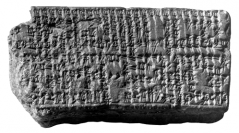

 Anthropozoologica
55 (8) - Pages 117-127
Anthropozoologica
55 (8) - Pages 117-127Mesopotamia has delivered, for nearly three millennia, an abundant textual documentation recorded on clay tablets. This corpus testifies, along with other iconographic supports, of the great interest regarding the animal world and its conceptualization. The lexical lists copied, developed, and reorganized over the centuries, but also scholarly sources, document the evolution of animal classifications, as well as the symbolic conceptions attached to certain species. Most of the work on Mesopotamian fauna retains from this rich corpus the emblematic series Ur5-ra = ḫubullu, composed of 24 tablets in its canonical version. Three of its tablets are entirely devoted to wildlife and have often served as a reference for studies aspiring to a synthetic understanding of the Mesopotamian zoological knowledge. However, an extended documentary spectrum with the texts in which animal classifications can sometimes appear more indirectly is also suitable to inform us about the categorization of animal species in the ancient Near East. Thus, by the comparative examination of sources of different natures dated from the first millennium B.C., this paper offers a reflection on the principles of animal world classification in Mesopotamia.
Mesopotamia, animal, taxonomy, classification, lexical texts.